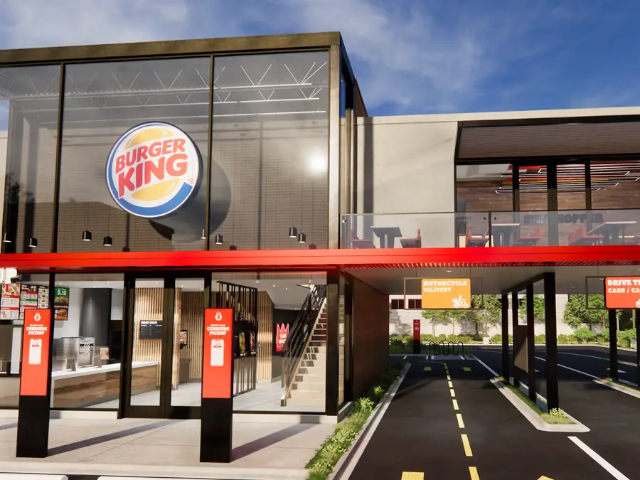As a result of the food service business disruptions and temporary (?), emergency changes in how they’ve done business during the COVID Era, many consumers may not have noticed other permanent changes the major players are trying to impose on them…
 The Burger King Resto Of The Future concept: Minimal
The Burger King Resto Of The Future concept: Minimal
eat-in seating; maximum accommodation for cars…
When Fast Food vendors changed their style to accommodate pandemic-mandated social distancing and ‘contactless’ takeout and delivery, they discovered that customers didn’t really mind the relatively minor inconveniences those stiffer rules imposed. The pandemic also gave them a chance to promote ordering and paying via smart phone apps and online systems. But now that restaurants of all kinds have been allowed to re-open in most places, the Fast Food mandarins are still pushing their online apps in an almost desperate frenzy. In fact, you can hardly take advantage of a special deal at any major Fast Food outlet these days without using their ordering app.
Take a step back…
Even before the pandemic hit, the major Fast Food brands were already starting to try out their ideas for ‘the restaurant of the future’ on their fans. McDonald’s was among the first to test drive ordering/paying kiosks (see photo, top of page) at its restos. It was also one of the first to reveal plans for its next generation restaurants. But the architectural and process changes being suggested at that time were mainly aimed at making the restaurants nicer places to visit and enjoy a family meal – like homier decor, table service and other upgraded amenities.
Once the pandemic came along, though, the major players realized they didn’t have to go to the trouble and expense of making their stores ‘nicer’. Taking the opposite approach and reducing dine-in accommodations would not only save on capital costs, but reduce staffing, cleaning and other costs in perpetuity, pumping up their profit lines.
Out of the pandemic into the fryer
And so, in the depths of the pandemic era, the Fast Food brain trusts got down to designing a new concept for their restaurants of the future. And the result – as exemplified by Burger King’s concept, is a vision every aspect of which seems to be aimed at cutting costs and maximizing revenues.
Among the changes planned are – as stated above – major reductions in dine-in seating capacity complemented by major increases in vehicular accommodations – both ‘drive-in’ style parking and enhanced traffic management on the lot. The idea is to keep people out of the store as much as possible, and in their cars, whether they’re just passing through to pick up an order or dining on the property. Rather than going into the resto to pick up their orders, most pass-through customers will be encouraged to use enhanced drive thru lanes or walk-up windows.
And one major change is in the vanguard of the campaign: the concerted push to get customers to use online and mobile apps for ordering and paying. Not to mention kiosks onsite. No more counters, no more counter staff. Orders will go directly to the kitchen and go out directly through the drive-thru window or the walk-up port.
Even so…
In spite of planned and incoming changes to the way they do business, industry watchers say constantly-increasing food and utility costs, not to mention municipal and sales taxes, will still push menu prices up.
Are you prepared to pay 30 to 50 percent more for a Fast Food meal – $9 to $12 for a Big Mac or a Whopper – within the next 5 years?
My take
I won’t be hitting the Fast Food joints as often as I have in the past. In fact, I pretty much cut out Fast Food altogether during the pandemic, regardless of how safe and convenient they made the option. As you know, I cooked at home as much as possible, and came up with a lot of new ideas, for breakfasts and suppers in particular. I guess I’m just old and stodgy, but I won’t start using phone or online ordering apps. I draw a line there. And I’ll be very sad the day human-staffed checkouts at supermarkets completely disappear. (They’ve already started to gently phase them out in favour of ‘Scan Yourself’ terminals!)
I’m still pretty skeptical about the accuracy of automated ordering and payment systems, too. What happens if I’m charged incorrectly for my order, or my order is wrong or incomplete? Who do I complain to?
I also bristle at the thought of navigating Fast Food store parking lots where they need traffic signs at every corner or – perish the thought – signal lights!
At the same time, I suspect that younger people will embrace the new Fast Food ‘store of the future’ as aggressively as I’ll avoid it. With every new generation comes a greater sense of personal entitlement and a stronger craving for convenience. And, apparently, they’re not adverse to paying more for the privilege of reduced service.
Muse on that…
~ Maggie J.

